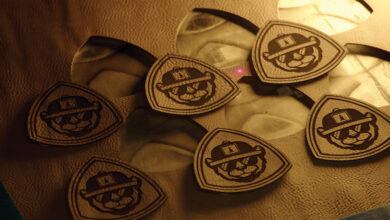For something different than brass on walnut wall plaques, awards retailers can offer sandcarved marble plaques. Though it is pretty easy to do, there are some considerations to keep in mind in order to keep from ruining your projects.
- In creating your layout, remember that the matrix of veins and different colors of marble actually make etched text difficult to read. The carved marble will be somewhat pebbly looking because the softer areas of the matrix carve deeper faster than the harder areas. Glass, for example, doesn’t do this at all, being a perfectly homogenous mixture.
- Avoid small text. Offer samples of different sizes on a piece of marble to see what you want to recommend as a minimum size to your customers. Most people recommend 18 to 20 points or larger.
- No matter what size of text (and graphic elements) you use, the marble matrix will still interfere with visual clarity unless you also color-fill the engraved elements. The most popular colors are metallic colors – either gold, silver, or copper. Other colors can also be used but don’t stand out as much.
- You will carve deeper than if you are etching on glass. This makes the lettering and graphics stand out more and have a higher quality look. This also means you will be blasting for a longer time at a higher pressure, so you should plan to use a thicker photoresist than you may be using on glass (I recommend at least a 5 or 6 millimeter resist for this).
- It is easier to sandcarve one letter at a time, then move on to the next letter.
- When cleaning, spray the alcohol-based window cleaner onto the cleaning cloth or paper towel rather than onto the marble. If you spray onto the marble, you run the risk of saturating the painted areas and having the water get under the paint. If it does, it can loosen the paint and it will eventually come off.
-Ruth Dobbins, EtchMaster



